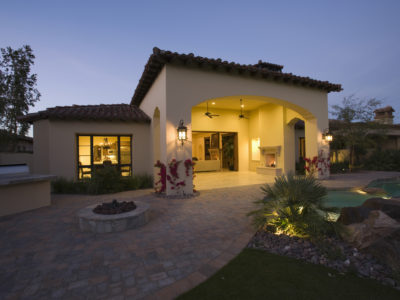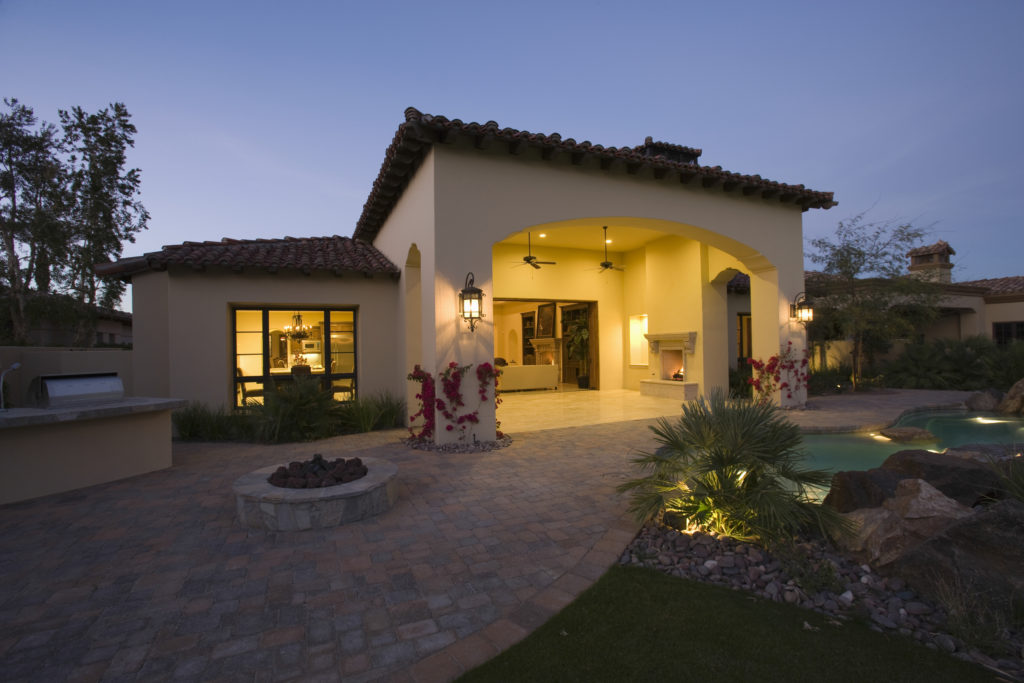
Well planned outdoor lighting will brighten your home in the evening and increase its curb appeal. Thoughtfully placed outdoor lights can highlight architectural and landscaping features, and create a warm, inviting atmosphere for yourself and your guests. Outdoor lighting serves many practical purposes, too. It helps us see our way along an otherwise dark pathway, walk up stairs without tripping, and get our key into the lock in the evening. It lights up our home’s street number so that delivery drivers and guests can find us, and helps us see who is at the door when someone comes by. It can also deter criminals from approaching our homes and ensure that there’s nowhere for them to hide.
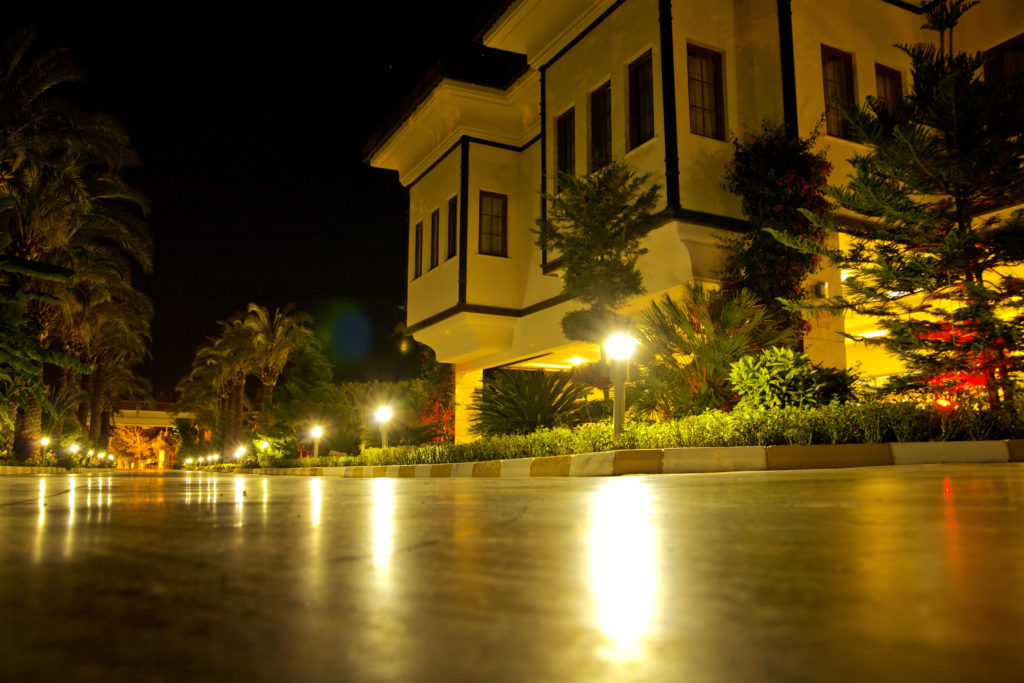
Types of Outdoor Lights
When it comes to lighting the exterior of your home, there is a vast array of styles and types of light fixtures to choose from, and they can be placed almost anywhere on your property.
Driveway
Adding a post light to the end of your driveway can add a traditional touch to your home, and lights along the driveway are attractive and inviting for you and your welcomed guests. But they are also a great way to deter unwanted intruders from approaching your home.
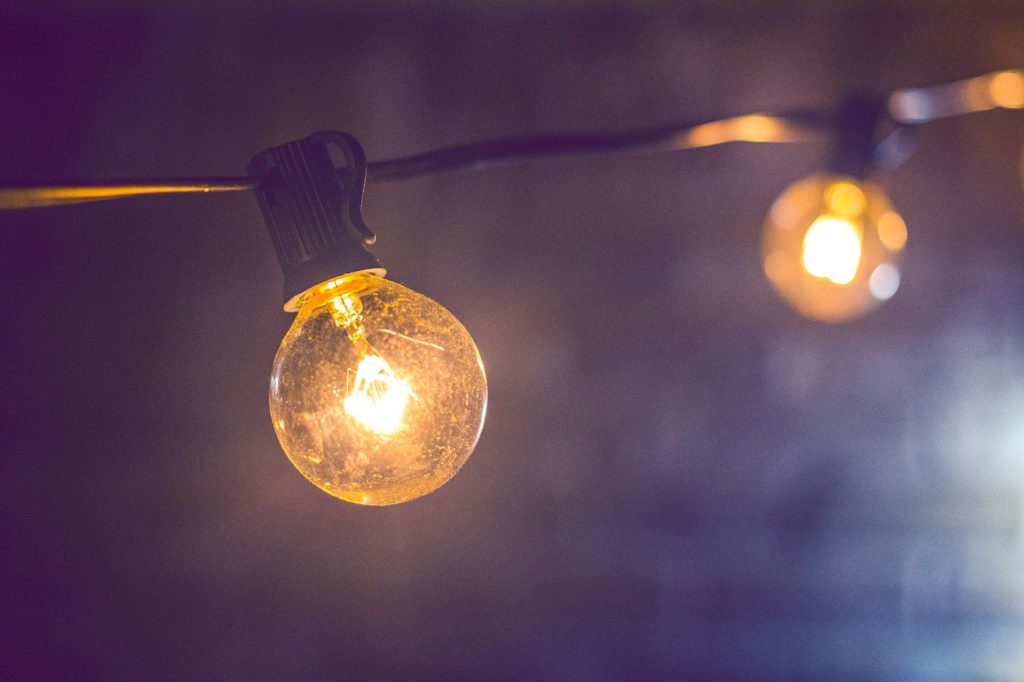
Garden & Yard
Adding lights to your garden and yard is not only a great way to highlight an attractive landscaping feature or light up a pathway, but it also helps to make your property more secure. There are many solar powered, LED kits available that can be installed in minutes. Wired options are a little more complicated to install, but are generally more reliable.
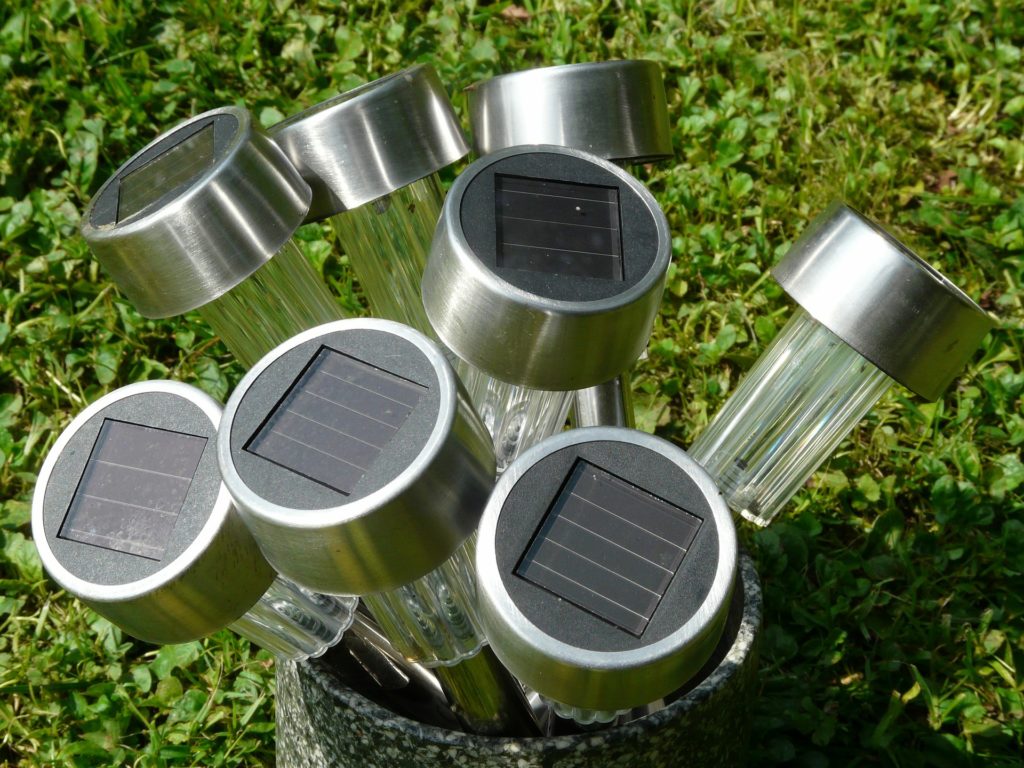
Deck
There are many locations on a deck that are perfect for installing lights – the only limit is your imagination! How you choose to light your deck really depends on how you use it. For entertaining guests, it’s best to keep the lighting warm and subtle. You want to create a cozy and inviting atmosphere that people will want to hang out in. The quickest and easiest option is a string of lights that you simply hang up and plug in.
You can add warmth and style with deck step lighting or with post cap lights on the deck posts. Another popular choice is under deck rail lighting. You can easily add strip lighting under the railing, or install recessed lights every few feet. If you do a lot of barbequing in the evening, you may want a brighter task light, like an overhead or wall light, that you can turn on for safety while you’re cooking.
We are experts in lighting
Do you have questions?
Wall Lighting
For safety and security it’s important to have a wall light at every entrance to your home and garage. They provide light to the entryway, the stairs, and the surrounding area. There are many styles and sizes to choose from. It’s best to choose fixtures that fit the style of your home, and are an appropriate size relative to your door.
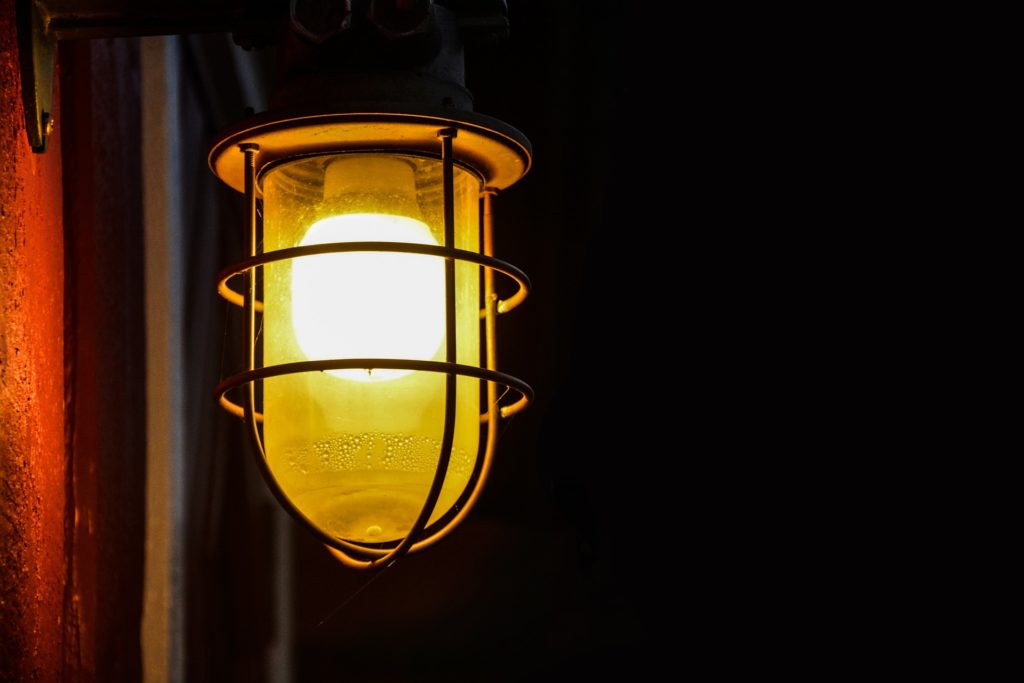
Soffit Lighting
Soffit lighting can be an attractive way to subtly add light to your home’s exterior. Soffit lights can also increase security by lighting up dark areas like the sides or corners of your home. These lights are recessed or pot lights with weatherproof covers, fit into the soffits of the home’s roof.
Floodlights
Floodlights are used to light up large areas. A well-placed floodlight can light up the front of your house or can be used to accent a landscaping feature, such as a tree or a boulder. Motion sensor floodlights are a good choice for security.
Create a Plan
Imagine driving or walking up to your home in the evening and think about how you’d like your home to look. Is there a driveway or a pathway that would look more welcoming with lights? Maybe there’s a design or landscaping feature that you could accent with a light? Do you have a deck or a patio that you’ll use for entertaining? Consider your needs and create a plan.
The three main categories for outdoor lighting are: ambient, task, and accent. Ambient lighting is subtle lighting that will be on most of the time. Think of it as ‘background lighting’ that gently lights up the space. The lights on your deck will generally be ambient lighting. Task lighting is a brighter light meant for a specific purpose, like working or cooking. Security lights also fall into this category. Accent lighting is used to highlight an attractive feature, like a tree or a boulder.
Make a map of your home’s exterior including the pathways, entrances, deck, and yard. With ambient, task, and accent lighting in mind, create a plan of the areas and features that you’d like lit. Be sure to include low level ambient lights as well as task lights for specific functions.
Security Considerations
Keeping the exterior of your home well-lit can help protect your property, and give you peace of mind when you come home late at night. When planning your lights, make sure there aren’t any dark spots where a criminal could hide. Lights should be placed at all entry points of the home, as well as the sides of the house and the backyard. Floodlights and spotlights on a motion sensor are an excellent way to deter any would-be criminals. But security lighting doesn’t have to be overly bright to be effective – even landscape accent lighting can provide security.
Many of us will leave a light on or set a light on a timer when we’re away, but professional criminals know to watch for these patterns. Products like Amazon’s Ring or Google’s Nest can be used remotely to randomly turn lights on and off, giving the appearance that someone is home. Even your Christmas tree can be turned on and off with Ring!
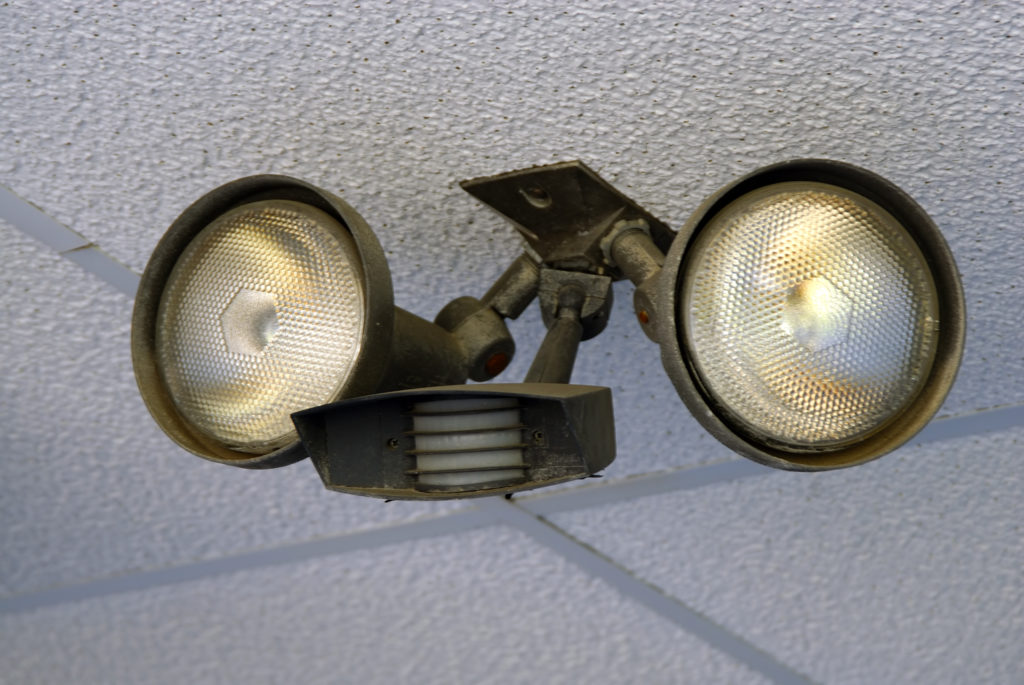
Powering the Lights
Once you’ve mapped out your ideal lighting design, you’ll need to consider how you’ll get power to the various light fixtures in your plan. Plugging in a string of lights on the patio is simple enough, but lighting your pathway or installing a floodlight in the garden can be a little more complicated.
Solar powered lights are a great choice for sunny areas of your property, and they come in a wide variety of styles. Since they don’t require wires they are easy to install. But as the name indicates, solar lights are powered by the sun. They need to be in areas where they’ll get enough consistent sunlight during the day to keep their batteries charged.
Battery powered lights are an option if you don’t live in a sunny climate, or you want lights for an area that doesn’t get much sun. These are just as easy to install as solar, but the drawback is the need to continually replace the batteries.
A better choice for lowlight areas is hardwired light fixtures. These come in two main options: line-voltage, and low-voltage. Line-voltage uses the same voltage (120 volts) as the appliances in your home. The high voltage means that extra care must be taken during installation and the wires cannot be left exposed. Line-voltage wiring is a job best left to professionals. Low-voltage is a safer option and is a better choice for most homeowners.
If you use wired fixtures, you’ll need to think about how you’ll run the wires to them from the power source. Line-voltage wires need to be protected in a conduit such as a PVC pipe and buried deep underground for safety. Whereas low-voltage wires don’t have to be buried too deep, and can even be concealed with mulch or gravel if that suits your landscaping.
Still have question?
We are just a phone call away.
587-700-0447
Buying the Lights
When the time comes to buy your light fixtures and accessories, there are many options to choose from, both in-store and online. It’s a good idea to spend some time checking out several different websites to see the available options and find the best price. Make sure you buy lights and parts that are rated for use in damp or wet exterior environments. Also, opt for LEDs wherever possible – they are energy efficient and low-maintenance. Customer reviews are a great way to see what other people have to say about the quality of a product before you buy it.
Here are some of the best lighting retailers. Click on the links to check out their websites.
Wayfair is an online retailer that provides an incredible selection of products. Prices range from low to high-end, and shipping is free to most areas on orders over $50. While they do offer 2 day shipping on some items, shipping can take quite a bit longer for other items.
Home Depot is one of the largest home improvement retailers in Canada. They offer a great selection of lighting options, both in-store and online. They also carry everything you’ll need to install your fixtures. Their staff are usually knowledgeable and can offer helpful advice. Depending on the weight of your order and where you live, shipping can be a little pricey if you order online.
Rona is a Canadian home improvement retailer with a great selection of products in a variety of price points. They offer free shipping on orders over $49, as well as free curb-side pickup. As an added bonus, Rona is partnered with Air Miles, so you’ll earn points on your purchase if you’re a collector.
Kichler is an American lighting company based in New York. They have a gorgeous selection of products, but they are a little pricey. Their international orders ship from the vendor to their warehouse and then to the customer, so it can take a while to receive your order. Keep in mind, they consider all international orders to be ‘final sale’, so you won’t be able to return the product if you’re not happy with it.
Canada Lighting Experts is actually an American company, but all products shown on their Canadian website are available to be shipped to Canada. The duties, taxes, and other fees are taken care of on their end. This means that their prices are a little higher than some of the other retailers, but they offer free shipping on orders over $79. Be aware that their prices are listed in American dollars, and some banks will charge a foreign currency fee.
Casa Di Luce is a Canadian retailer, specializing in the latest European light fixtures. They offer high-end products and free shipping in Canada on orders over $200. Their only showroom is in Toronto, so unless you’re in that area, ordering online is your only option.
Canadian Tire has a great selection of light fixtures, as well as all the hardware and tools you’ll need to install them. They offer in-store or curb-side pickup if you order online. Shipping items to your home can be a little costly depending on your location.
While the in-store selection is limited, Costco’s website has a decent selection of lighting fixtures to choose from. You do have to be a member in order to shop at Costco, but the great deals on products make the membership fee worthwhile.
Lighting Originals is a Canadian company that carries a great selection of light fixtures. They offer products from local and international designers, as well as original pieces they design and manufacture themselves. They offer free shipping in Canada on orders over $100. On orders less than $100, there is a low $8 shipping fee. Their only showroom is in Toronto, so online ordering is your only option if you live elsewhere.
Amazon offers a huge selection of products in a wide range of price points. Their shipping is usually fast and is free for orders over $35. But be careful when ordering – Amazon marketplace offers items from 3rd party sellers that are often in other countries. Shipping from them is not always free and can take a very long time!
Installing the Lights
Once you’ve determined your requirements and purchased the hardware, it’s time for installation. If you’re using solar or battery powered fixtures, you can easily install them yourself, but installation involving wiring is complicated and dangerous. Unless you have experience with wiring and electrical, you should hire a professional to come and help. They are experienced in all aspects of outdoor lighting wiring and home exterior lighting installation.
Always make sure to turn your breaker off to avoid electric shock before starting work.
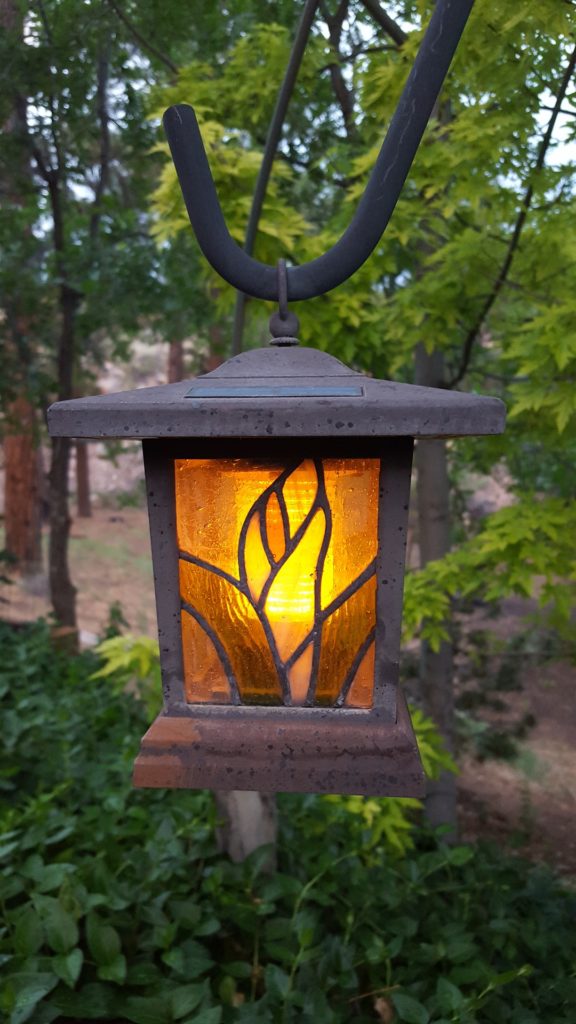
Outdoor Lighting
For all hard-wired outdoor lights, it’s best to use low-voltage options. These systems use a transformer to decrease the voltage from your home’s electrical, down to a safe level for outdoor use. This transformer simply plugs into an outdoor electrical outlet (GFCI). Make sure the transformer is capable of powering all the lights you plan to attach to it, or you may need a bigger transformer. Have a wiring diagram in place before you begin so you’ll know exactly where the fixtures are going and how much wire you’ll need.
Attach the fixture’s wires to the transformer by screwing them into place – follow the directions given by the manufacturer. Mount the transformer beside the GFCI outlet. Once the fixtures are in place, run the wires from the transformer to the lights. Test the lights to make sure they work properly. Once you’re sure everything’s working well, you can hide the wires. Wires can be hidden behind siding, in the rails and posts of your deck, or buried underground.
Soffit Lighting
To determine how many lights you’ll need, measure the length of soffit you want lit. The spacing of your soffit lights is determined by the size of the lights you are installing. If your lights are 4 inches in diameter, install them 4 feet apart; if your lights are 6 inches, install them 6 feet apart. It’s best to use a soft bulb and place them sparingly in a few key areas or they can make a home look like a spaceship coming in for a landing!
Once you’ve determined the location of the lights, trace the diameter of the light fixture at each spot and cut a hole for the fixture. Run wires to each hole from your power source, leaving a loop of about 10 inches at each location for attaching the fixtures. Prepare the wires, attach the fixture, and place it into the pre-cut hole. This is a complicated task that is best left to a professional!
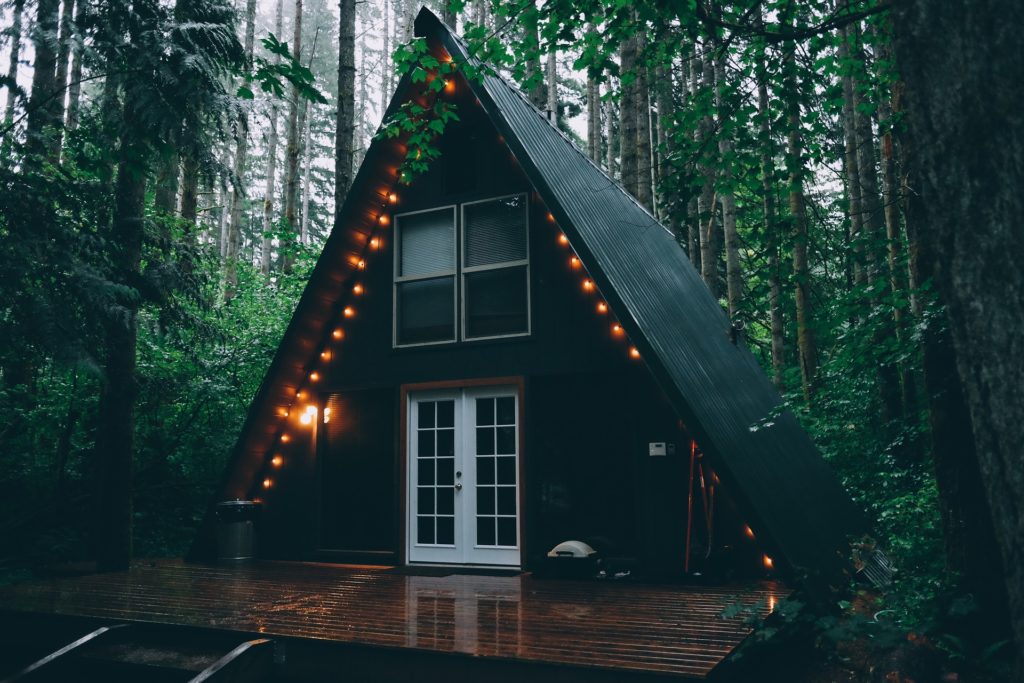
Wall Lighting
Outdoor wall lights should be installed at all entrances of the home, as well as on the exterior of your garage. A light on either side of the door looks nice if you have the space, otherwise they should be placed on the doorknob side of the door, at about shoulder height. Replacing a wall light is a fairly straightforward job, but be sure and consult a professional for installing exterior light fixtures or installing exterior garage lighting in a new spot – this is not a job for a beginner.
FAQ
How do I put lights on deck stairs?
Determine exactly where you’d like your lights to be – will they be on the centre of each stair’s riser, on the overhang of each step, or on the side of the stairs? How difficult it is to install them will depend on your light fixture itself. If the fixture is solar-powered, just place the fixture where you’d like it to be and screw it in place. If the fixture is wired, it’s a more complicated process. You’ll need to drill a hole large enough to insert the fixture snugly. Run wires from the transformer to each hole, and wire up each fixture before fitting it into the hole. Unless you have experience with wiring, it’s a good idea to consult a professional for this task.
How much will deck lighting installation cost?
It would take a professional about 4 to 5 hours to install most deck lighting. Materials are an additional $200 to $500, depending on the brand and type of fixtures you choose, as well as the distance from the electrical panel. Most deck lights are low-voltage, however the transformer has to be in a weatherproof enclosure, and the circuit has to be GFCI (Ground Fault Circuit Interrupter) protected. If these requirements aren’t already in place, they’ll need to be installed for an additional cost.
How can I hide deck light wiring?
The structure of the deck gives you many options for hiding wires. You can run the wire under the deck boards, inside the deck posts, or under the railing. Many deck posts and rails are hollow so that wiring can be run through them, otherwise you’ll have to drill holes or channels to accommodate the wires. Wire concealing wood trim is another attractive way to hide and protect wires.
How can I hide garden light wiring?
There are many clever ways to hide the wiring for garden lights. You can use mulch or gravel in certain areas, but the best option is to bury the wires underground. Contact your utility companies to have them mark where pipes or cables are buried in your yard beforehand. Once you’ve installed your lights, run the wiring above the ground. Use a shovel to dig a 6 to 12 inch trench. If your wires are ‘direct bury’, they can go directly into the trench, otherwise, protect the wires by placing them inside a ‘conduit’ or PVC pipe before burying them into the trench. Replace the dirt and sod over your wires and stamp it down with your feet to pack it down.
Are solar powered lights reliable?
These lights are equipped with a small solar panel and a battery. The solar panel charges the battery and the battery powers the light during the night. In order to function reliably, solar lights require plenty of direct sunlight on a regular basis. If the solar panel doesn’t get enough direct sunlight, the battery will drain, and your lights won’t work.
